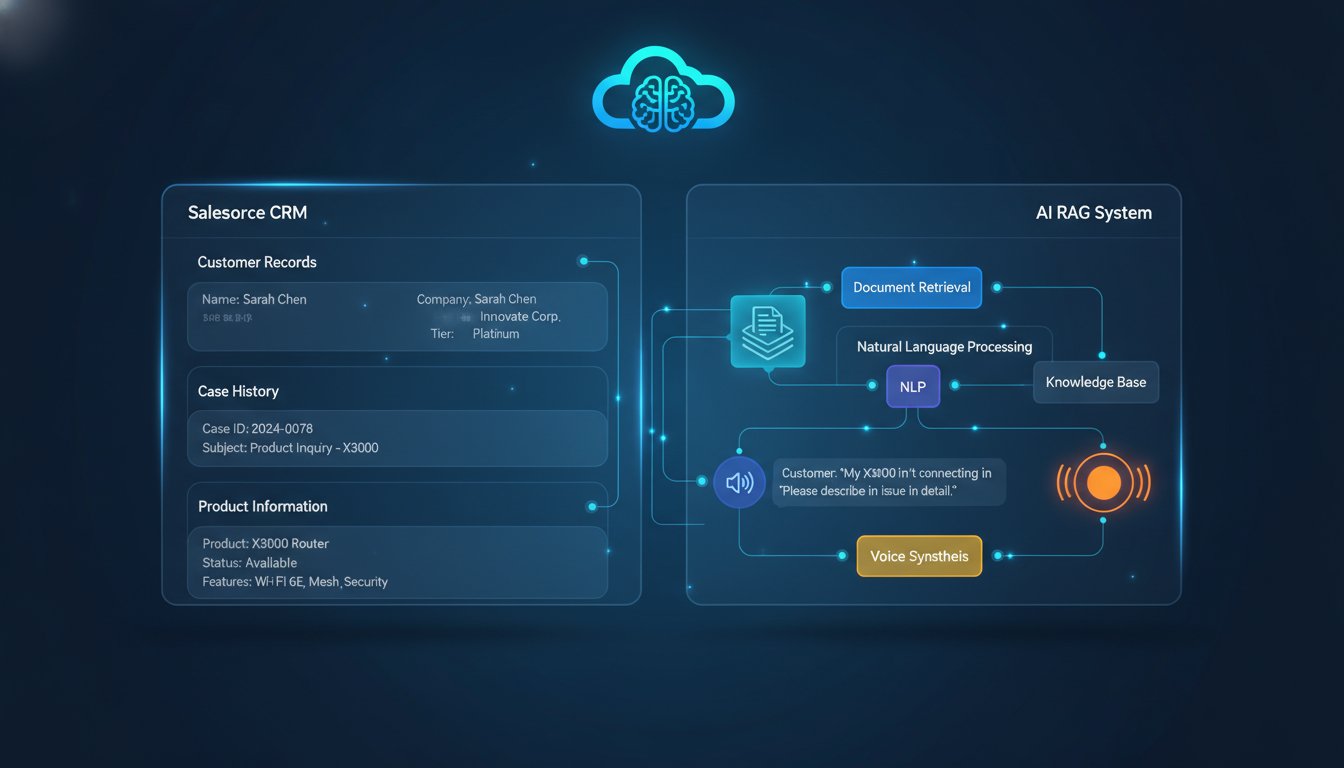Enterprise AI teams are hitting a wall with traditional vector databases. While companies rush to implement RAG systems, they’re discovering that single-vector approaches can’t handle the complexity of real-world enterprise data. Documents contain structured tables, unstructured text, metadata, and contextual relationships that pure semantic search simply can’t capture effectively.
The solution isn’t just better embeddings or larger models—it’s hybrid search architecture that combines vector similarity with traditional keyword matching and metadata filtering. Qdrant’s latest hybrid search capabilities represent a significant leap forward, offering production-grade performance that can handle enterprise-scale workloads while maintaining the precision needed for mission-critical applications.
In this comprehensive guide, we’ll build a complete production RAG system using Qdrant’s hybrid search features. You’ll learn how to implement dense and sparse vector indexing, configure advanced filtering strategies, and deploy a system that can scale to millions of documents while maintaining sub-100ms query response times. By the end, you’ll have a battle-tested architecture that combines the best of semantic and lexical search.
Understanding Qdrant’s Hybrid Search Architecture
Qdrant’s hybrid search combines three distinct search methodologies into a unified ranking system. Dense vectors capture semantic meaning through transformer-based embeddings, sparse vectors handle exact keyword matching using techniques like BM25, and payload filtering enables precise metadata-based queries.
The breakthrough lies in Qdrant’s fusion scoring algorithm, which intelligently weights each search component based on query characteristics. When users search for specific product codes or exact phrases, the system prioritizes sparse vector results. For conceptual queries about “customer satisfaction trends,” dense vectors dominate the scoring.
Dense Vector Implementation Strategy
Dense vectors form the semantic backbone of your hybrid search system. Qdrant supports multiple embedding models simultaneously, allowing you to optimize for different content types within the same collection.
from qdrant_client import QdrantClient
from qdrant_client.models import Distance, VectorParams, PointStruct
import openai
from sentence_transformers import SentenceTransformer
class HybridRAGSystem:
def __init__(self):
self.client = QdrantClient(url="your-qdrant-url", api_key="your-api-key")
self.dense_model = SentenceTransformer('all-MiniLM-L6-v2')
self.openai_client = openai.OpenAI()
def create_collection(self, collection_name: str):
"""Create collection with hybrid search configuration"""
self.client.create_collection(
collection_name=collection_name,
vectors_config={
"dense": VectorParams(size=384, distance=Distance.COSINE),
"sparse": VectorParams(
size=1000,
distance=Distance.DOT,
on_disk=True # Optimize for memory usage
)
},
sparse_vectors_config={
"text": {
"index": {
"type": "inverted_index",
"options": {
"tokenizer": "word",
"lowercase": True,
"stem": True
}
}
}
}
)
Sparse Vector Generation with BM25
Sparse vectors capture lexical patterns that dense embeddings often miss. Qdrant’s implementation uses an optimized BM25 algorithm with configurable parameters for term frequency and document length normalization.
from sklearn.feature_extraction.text import TfidfVectorizer
import numpy as np
class SparseVectorGenerator:
def __init__(self, vocab_size=10000):
self.vectorizer = TfidfVectorizer(
max_features=vocab_size,
stop_words='english',
ngram_range=(1, 2),
sublinear_tf=True
)
self.fitted = False
def fit_transform(self, documents):
"""Fit vectorizer and transform documents"""
sparse_matrix = self.vectorizer.fit_transform(documents)
self.fitted = True
return self._to_qdrant_sparse(sparse_matrix)
def transform(self, documents):
"""Transform new documents using fitted vectorizer"""
if not self.fitted:
raise ValueError("Vectorizer not fitted. Call fit_transform first.")
sparse_matrix = self.vectorizer.transform(documents)
return self._to_qdrant_sparse(sparse_matrix)
def _to_qdrant_sparse(self, sparse_matrix):
"""Convert scipy sparse matrix to Qdrant sparse vector format"""
vectors = []
for i in range(sparse_matrix.shape[0]):
row = sparse_matrix.getrow(i)
indices = row.indices.tolist()
values = row.data.tolist()
vectors.append({"indices": indices, "values": values})
return vectors
Document Processing and Indexing Pipeline
Production RAG systems require robust document processing that maintains data lineage while optimizing for retrieval performance. Your pipeline must handle document chunking, metadata extraction, and vector generation at scale.
Intelligent Document Chunking
Effective chunking preserves semantic coherence while maintaining optimal chunk sizes for your embedding model. Implement semantic chunking that respects document structure and maintains context boundaries.
import tiktoken
from typing import List, Dict, Any
class SemanticChunker:
def __init__(self, model_name="gpt-3.5-turbo", chunk_size=512, overlap=50):
self.encoding = tiktoken.encoding_for_model(model_name)
self.chunk_size = chunk_size
self.overlap = overlap
def chunk_document(self, text: str, metadata: Dict[str, Any]) -> List[Dict[str, Any]]:
"""Chunk document while preserving semantic boundaries"""
sentences = self._split_into_sentences(text)
chunks = []
current_chunk = []
current_tokens = 0
for sentence in sentences:
sentence_tokens = len(self.encoding.encode(sentence))
if current_tokens + sentence_tokens > self.chunk_size and current_chunk:
# Create chunk with overlap
chunk_text = " ".join(current_chunk)
chunks.append(self._create_chunk(chunk_text, metadata, len(chunks)))
# Start new chunk with overlap
overlap_sentences = current_chunk[-self.overlap:] if len(current_chunk) > self.overlap else current_chunk
current_chunk = overlap_sentences + [sentence]
current_tokens = sum(len(self.encoding.encode(s)) for s in current_chunk)
else:
current_chunk.append(sentence)
current_tokens += sentence_tokens
# Add final chunk
if current_chunk:
chunk_text = " ".join(current_chunk)
chunks.append(self._create_chunk(chunk_text, metadata, len(chunks)))
return chunks
Metadata Enrichment Strategy
Qdrant’s payload filtering capabilities enable sophisticated query routing based on document metadata. Design your metadata schema to support common filtering patterns while maintaining query performance.
class MetadataExtractor:
def __init__(self):
self.entity_extractor = self._initialize_ner_model()
def extract_metadata(self, text: str, source_metadata: Dict[str, Any]) -> Dict[str, Any]:
"""Extract rich metadata for enhanced filtering"""
base_metadata = {
"source": source_metadata.get("source", "unknown"),
"document_type": self._classify_document_type(text),
"language": self._detect_language(text),
"content_length": len(text),
"complexity_score": self._calculate_complexity(text),
"timestamp": source_metadata.get("created_at"),
"department": source_metadata.get("department", "general")
}
# Extract entities for advanced filtering
entities = self.entity_extractor(text)
base_metadata.update({
"entities": {
"persons": [ent for ent in entities if ent["label"] == "PERSON"],
"organizations": [ent for ent in entities if ent["label"] == "ORG"],
"locations": [ent for ent in entities if ent["label"] == "GPE"]
},
"topics": self._extract_topics(text)
})
return base_metadata
Advanced Query Processing and Fusion Scoring
Hybrid search effectiveness depends on intelligent query analysis and dynamic score fusion. Implement query classification that routes different query types to optimal search strategies.
Query Classification and Routing
Analyze incoming queries to determine the optimal balance between semantic and lexical search. Queries containing specific identifiers, dates, or exact phrases should weight sparse vectors higher, while conceptual queries favor dense vector similarity.
import re
from enum import Enum
class QueryType(Enum):
SEMANTIC = "semantic"
LEXICAL = "lexical"
HYBRID = "hybrid"
FILTERED = "filtered"
class QueryAnalyzer:
def __init__(self):
self.exact_patterns = [
r'\b[A-Z]{2,}-\d+\b', # Product codes
r'\b\d{4}-\d{2}-\d{2}\b', # Dates
r'"[^"]+"', # Quoted phrases
r'\b[A-Z]{3,}\b' # Acronyms
]
def analyze_query(self, query: str) -> Dict[str, Any]:
"""Analyze query to determine optimal search strategy"""
query_lower = query.lower()
# Check for exact match patterns
exact_matches = sum(1 for pattern in self.exact_patterns
if re.search(pattern, query))
# Analyze query characteristics
analysis = {
"query_type": self._classify_query_type(query, exact_matches),
"dense_weight": self._calculate_dense_weight(query, exact_matches),
"sparse_weight": self._calculate_sparse_weight(query, exact_matches),
"filter_conditions": self._extract_filters(query),
"query_complexity": len(query.split()),
"contains_quotes": '"' in query,
"contains_boolean": any(op in query_lower for op in ['and', 'or', 'not'])
}
return analysis
def _calculate_dense_weight(self, query: str, exact_matches: int) -> float:
"""Calculate optimal dense vector weight based on query characteristics"""
base_weight = 0.7
# Reduce dense weight for exact patterns
if exact_matches > 0:
base_weight *= (1 - (exact_matches * 0.2))
# Increase for conceptual queries
conceptual_terms = ['how', 'why', 'what', 'explain', 'describe', 'analyze']
if any(term in query.lower() for term in conceptual_terms):
base_weight += 0.2
return max(0.1, min(0.9, base_weight))
Fusion Scoring Implementation
Implement Reciprocal Rank Fusion (RRF) with dynamic weighting based on query analysis. This approach combines rankings from different search methods while maintaining score interpretability.
class HybridSearchEngine:
def __init__(self, rag_system: HybridRAGSystem):
self.rag_system = rag_system
self.query_analyzer = QueryAnalyzer()
def hybrid_search(self, query: str, collection_name: str,
limit: int = 10, filters: Dict = None) -> List[Dict]:
"""Perform hybrid search with dynamic score fusion"""
# Analyze query characteristics
query_analysis = self.query_analyzer.analyze_query(query)
# Generate query vectors
dense_vector = self.rag_system.dense_model.encode(query).tolist()
sparse_vector = self.rag_system.sparse_generator.transform([query])[0]
# Perform searches
dense_results = self._dense_search(dense_vector, collection_name, limit * 2, filters)
sparse_results = self._sparse_search(sparse_vector, collection_name, limit * 2, filters)
# Fuse results using RRF with dynamic weights
fused_results = self._reciprocal_rank_fusion(
dense_results,
sparse_results,
query_analysis["dense_weight"],
query_analysis["sparse_weight"]
)
return fused_results[:limit]
def _reciprocal_rank_fusion(self, dense_results: List, sparse_results: List,
dense_weight: float, sparse_weight: float,
k: int = 60) -> List[Dict]:
"""Combine search results using weighted RRF"""
# Create ranking maps
dense_ranks = {result.id: i + 1 for i, result in enumerate(dense_results)}
sparse_ranks = {result.id: i + 1 for i, result in enumerate(sparse_results)}
# Calculate fusion scores
all_ids = set(dense_ranks.keys()) | set(sparse_ranks.keys())
fusion_scores = {}
for doc_id in all_ids:
dense_score = dense_weight / (k + dense_ranks.get(doc_id, len(dense_results) + 1))
sparse_score = sparse_weight / (k + sparse_ranks.get(doc_id, len(sparse_results) + 1))
fusion_scores[doc_id] = dense_score + sparse_score
# Sort by fusion score and return results
sorted_ids = sorted(fusion_scores.keys(), key=lambda x: fusion_scores[x], reverse=True)
# Reconstruct result objects
id_to_result = {}
for result in dense_results + sparse_results:
if result.id not in id_to_result:
id_to_result[result.id] = result
return [id_to_result[doc_id] for doc_id in sorted_ids if doc_id in id_to_result]
Production Deployment and Scaling Strategies
Deploying hybrid RAG systems at enterprise scale requires careful attention to performance optimization, monitoring, and fault tolerance. Implement caching strategies, connection pooling, and graceful degradation patterns.
Performance Optimization Techniques
Qdrant’s performance can be significantly improved through proper indexing strategies, payload optimization, and query batching. Configure your deployment for your specific workload characteristics.
from qdrant_client.models import OptimizersConfigDiff, HnswConfigDiff
import asyncio
from typing import List
class ProductionRAGSystem:
def __init__(self):
self.client = QdrantClient(
url="your-qdrant-cluster-url",
api_key="your-api-key",
timeout=30,
prefer_grpc=True # Use gRPC for better performance
)
self.cache = self._initialize_cache()
def optimize_collection(self, collection_name: str):
"""Apply production optimization settings"""
self.client.update_collection(
collection_name=collection_name,
optimizer_config=OptimizersConfigDiff(
default_segment_number=4, # Optimize for your CPU cores
max_segment_size=20000, # Balance memory vs performance
memmap_threshold=20000, # Use memory mapping for large segments
indexing_threshold=10000, # Start indexing after threshold
flush_interval_sec=30, # Batch writes for performance
max_optimization_threads=2
),
hnsw_config=HnswConfigDiff(
m=16, # Connectivity factor
ef_construct=200, # Build-time search width
full_scan_threshold=10000, # Switch to exact search for small collections
max_indexing_threads=4, # Parallel indexing
on_disk=True # Store index on disk for large collections
)
)
Monitoring and Observability
Implement comprehensive monitoring to track search performance, relevance metrics, and system health. Use distributed tracing to identify bottlenecks in your RAG pipeline.
import time
import logging
from dataclasses import dataclass
from typing import Optional
@dataclass
class SearchMetrics:
query_time: float
result_count: int
dense_score_avg: float
sparse_score_avg: float
cache_hit: bool
class RAGMonitor:
def __init__(self):
self.logger = logging.getLogger(__name__)
self.metrics_buffer = []
def track_search(self, query: str, results: List, start_time: float,
cache_hit: bool = False) -> SearchMetrics:
"""Track search performance metrics"""
end_time = time.time()
query_time = end_time - start_time
metrics = SearchMetrics(
query_time=query_time,
result_count=len(results),
dense_score_avg=self._calculate_avg_score(results, "dense"),
sparse_score_avg=self._calculate_avg_score(results, "sparse"),
cache_hit=cache_hit
)
# Log performance warnings
if query_time > 1.0:
self.logger.warning(f"Slow query detected: {query_time:.2f}s for query: {query[:100]}")
if len(results) == 0:
self.logger.warning(f"No results found for query: {query[:100]}")
self.metrics_buffer.append(metrics)
return metrics
Advanced Features and Future Considerations
As your RAG system matures, consider implementing advanced features like multi-modal search, federated querying across multiple collections, and adaptive learning from user feedback.
Multi-Modal Document Processing
Extend your system to handle images, tables, and structured data within documents. Qdrant’s payload system can store multiple vector representations for different content modalities.
from PIL import Image
import torch
from transformers import CLIPProcessor, CLIPModel
class MultiModalProcessor:
def __init__(self):
self.clip_model = CLIPModel.from_pretrained("openai/clip-vit-base-patch32")
self.clip_processor = CLIPProcessor.from_pretrained("openai/clip-vit-base-patch32")
def process_document(self, document_path: str) -> Dict[str, Any]:
"""Process document with text, images, and tables"""
content = self._extract_content(document_path)
vectors = {
"text_dense": self._encode_text(content["text"]),
"text_sparse": self._encode_text_sparse(content["text"])
}
# Process images if present
if content["images"]:
image_vectors = []
for image in content["images"]:
img_vector = self._encode_image(image)
image_vectors.append(img_vector)
vectors["images"] = image_vectors
# Process tables as structured data
if content["tables"]:
table_vectors = []
for table in content["tables"]:
table_text = self._table_to_text(table)
table_vector = self._encode_text(table_text)
table_vectors.append(table_vector)
vectors["tables"] = table_vectors
return {
"vectors": vectors,
"content": content,
"metadata": self._extract_metadata(content)
}
Building a production-ready RAG system with Qdrant’s hybrid search capabilities requires careful attention to architecture, performance, and scalability. The combination of dense and sparse vectors, intelligent query routing, and dynamic score fusion creates a robust foundation for enterprise AI applications.
Start with the core implementation outlined in this guide, then gradually add advanced features based on your specific use case requirements. Monitor performance metrics closely and iterate on your chunking strategies, vector generation, and fusion algorithms based on real-world usage patterns.
Ready to transform your enterprise knowledge retrieval? Implement this hybrid RAG architecture in your organization and experience the power of truly intelligent document search. Begin with a pilot project, measure the impact on user query satisfaction, and scale gradually to handle your entire knowledge base.




